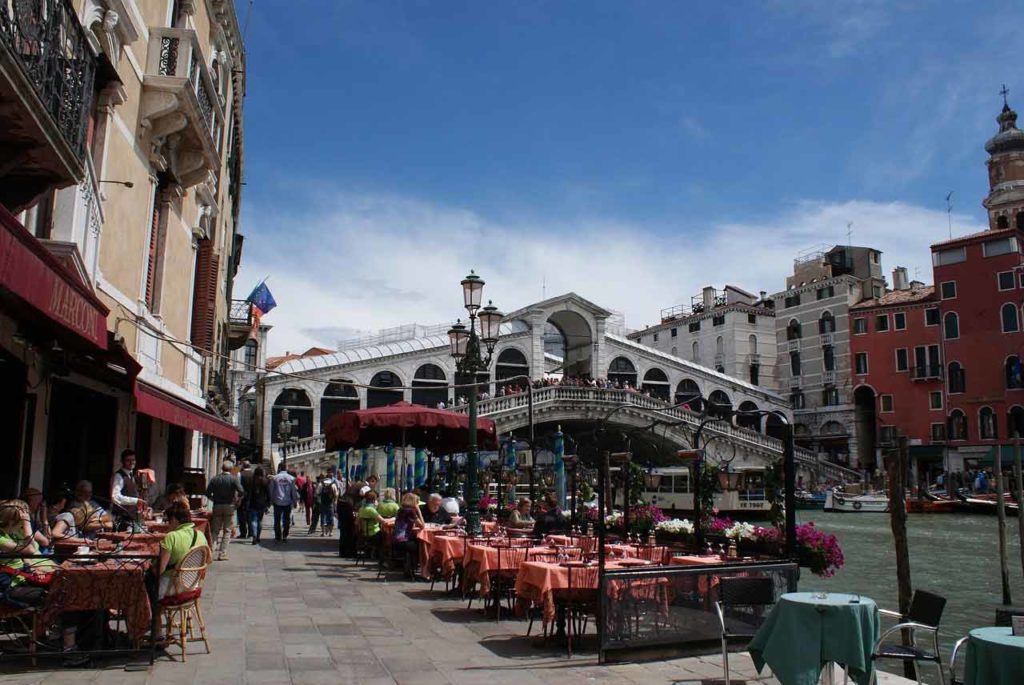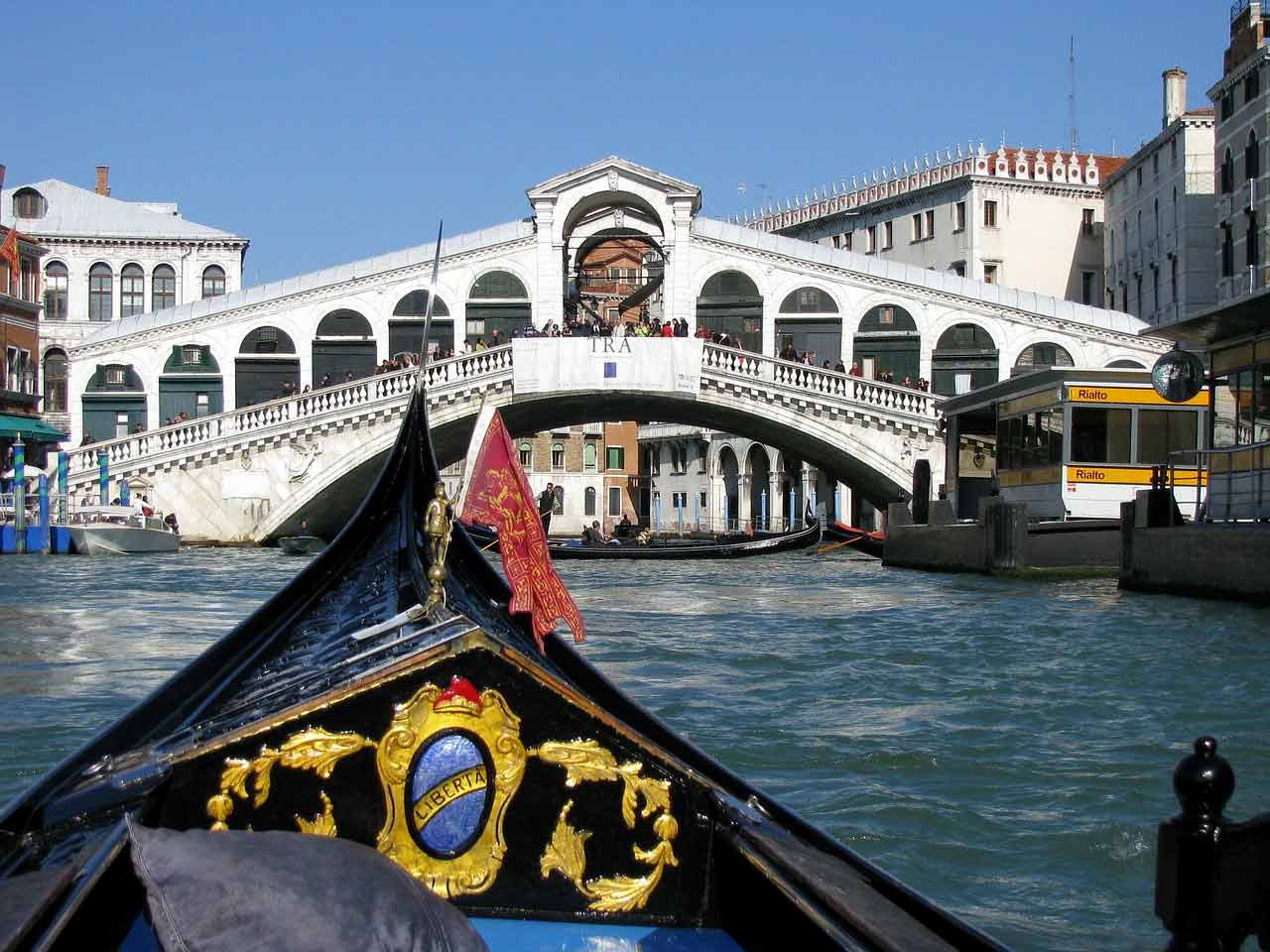
Venice is an enchanting, mysterious, romantic city. The streets of the lagoon city consist of water canals. This not only inspires lovers to dream of balmy summer nights. The gondolas glide gently and silently along the Grand Canal under the Rialto Bridge. This bridge is one of the most painted and photographed motifs of Venice.
Located in the commercial center, the Rialto, it crosses the Grand Canal and connects the two parts of the city. It gets its name from the district. Its name is derived from the words rio for river and alto for high, which means that this quarter is not flooded at high tide.
An architectural masterpiece emerges

The Rialto Bridge as we know it today was built in the 16th century. But there were forerunners made of wood as early as the Middle Ages. Until then various wooden bridges that crossed the Grand Canal had repeatedly burned down, one such wooden bridge even collapsed under a crowd of people in the mid-15th century. Even then, merchants, money changers, and goldsmiths had settled there, because the city had auctioned off the shops there at extremely high prices. Therefore, in 1507, it was decided to build a stone bridge on this spot. Nevertheless, the old wooden bridge was still renovated in 1524 after it had been damaged in a great fire.
The competition held in Venice for the new bridge design attracted high-ranking artists such as Michelangelo, who had been asked by the Doge himself for a design, and Palladio. In the end, however, Antonio da Ponte and Giovanni Alvise Boldu were able to secure the contract. However, the new building was delayed until the collapse of some buildings on the bank freed up building space. Then it was moved in 1591. Until the 19th century, this bridge remained the only footpath across the Grand Canal…
Rialto Bridge tour and entrance fees
✅ There is only good news here. Visiting and crossing the Rialto Bridge is free day and night. Perhaps one reason why it can get so endlessly crowded here.
❌ There can be waiting times when thousands of tourists push their way across the individual ramps during the day.
Architecture of the bridge

Antonio da Ponte’s design initially envisaged a bridge with three arches. The Rialto Bridge, which was then realized, consists of only one arch without a central pier and thus enables a faster flow of traffic. This design also allows large ships to pass under the bridge without any problems.
Access to the 48-metre-long bridge is from the shore via ramps. Four ramps were originally planned. However, there was not enough space for the fourth ramp, so only three were actually built. The bridge itself is held in place by over 10,000 oak piles in the ground. On the bridge, two rows of shops are set under limestone arcades that can be closed with a wooden shutter. A covered viewing platform crowns the bridge.
The steps of the bridge are designed so that you can cross it without getting tired. The same master builder of this bridge also built another world-famous bridge in Venice, the Bridge of Sighs.
The architecture of the bridge with its Renaissance superstructures is obviously also influenced by a design by Vincenzo Scamozzi. Unfortunately, the frescoes painted by Titian have disappeared today, but the bridge compensates for this with its white splendor.
Photographing at the Rialto Bridge
Of course, the Rialto Bridge is one of the most photographed structures in the world. Nevertheless, crowds of tourists are drawn up the narrow steps to the top of the bridge to get the best shot of the Grand Canal with its magnificent palaces and bustling boat traffic.
Photo amateurs will find endless motifs in Venice and the memory disks and cards of smartphones and cameras fill up quickly. For the unusual and unknown motifs, professional tours or taking part in a private photo tour will help at almost any time of day.
Still in the spotlight today

Although four bridges cross the Grand Canal today, the Rialto Bridge was the only one for a long time. Thus, the city center developed around it. Even today, the city hall, the stock exchange, a luxury department store’ that opened in 2016, and a small market, the Rialto Market, are located near it.
The bridge is one of the main tourist attractions in Venice. In the rows of shops that are still in operation today, souvenirs are offered alongside gold jewelry. Some of these shops have become tourist attractions themselves.
The ferries can pass under the bridge, so this is also an impressive motif for a photo. The Rialto Bridge has survived the ages and many an earthquake unscathed.
In 425 years, it has not been renovated once. Only now is it necessary. A lot of money was needed to renovate the 400-year-old Rialto Bridge. Five million euros were raised by a huge advertising poster for jeans that was stretched across the bridge.
Legendary stories about the Rialto Bridge
A dark legend surrounds the construction of the bridge. The master builder, who was under pressure, is said to have promised the devil the first soul to cross the bridge, as the devil had previously caused the structure to collapse several times.
After the work was completed, the master builder had the bridge closed for this reason. But the devil came to the master builder’s wife in human form and told her that her husband urgently wanted to see her.
The soldiers blocking the bridge recognized her, did not dare to stop her, and let her pass. In her belly, the child entered the bridge before she did. This is how the devil is said to have received his reward for helping to build the bridge.
The famous kiss under the Rialto Bridge

Venice is considered one of the most romantic cities in the world. Marriage proposals are made on rickety gondolas or on small picturesque bridges. According to legend, a kiss under the Bridge of Sighs during sunset promises eternal love. Many then end the day with a delicious meal in a nearby authentic, typical Venetian restaurant. On the Grand Canal, boats have been sailing under the world-famous Rialto Bridge for centuries, because here too, lovers from all over the world say that a kiss under the bridge is supposed to bring happiness.
But how do you get under the bridge? For those who are in love and thrifty, a ride on the public Vaparetto is enough. The stops before or after the Rialto Bridge on line 1 are Rialto and Rialto Mercado. Otherwise, you can also comfortably take one of the numerous boat tours on the Grand Canal, which also passes under the Rialto Bridge.
🛶 Of course, the highlight remains the gondola ride, because what would Venice be without a gondola ride on the Grand Canal? The ultimate is of course a gondola ride to the Rialto Bridge. So grab a gondola near the bridge and when the gondolier sings “Oh, sole mio” and the water laps to it, the famous kiss will come all by itself.
Gondola rides on the Rialto Bridge

The tours mentioned in my Gondola Rides section above depart mainly from the area around St Mark’s Square. Gondola rides at the Rialto Bridge can therefore only be organized individually. The cost of a private gondola tour ranges from €100 to €120 during the day; towards the evening, when the craving for romance increases, especially at sunset, it can easily become a little more expensive. The negotiated price for a private tour is always for a gondola up to a maximum of 6 people. At many gondola stations near the Rialto Bridge there are now also signs with clear price information, so there should be no misunderstandings about pricing. If you feel like it, you can set the mood for the evening very close to the Rialto Bridge with a refreshing Spritz experience, Un Mondo Di Vino wine house, Salizada San Canzian 5984A, just 4 minutes away.
A ride on a gondola is a great experience, but unfortunately never cheap and always a burden on the holiday budget. If you still want to experience the gondola feeling and can do without a gondola ride under the Rialto Bridge with a heavy heart, you can cross the Grand Canal with a Traghetto ferry. This is actually the most beautiful way to cross Venice’s main waterway. This is a normal gondola that helps 10 to 12 people cross the Grand Canal in a few minutes for about €3.00. The ferry is usually open from 9:00 a.m. to 9:00 p.m. The whole thing usually runs from 9:00 to 18:00. The nearest landing stage to the Rialto Bridge is Traghetto di Santa Sofia at the Rialto Fish Market.
The Rialto Bridge at night!

A special magic envelops Venice at night. When the alleys of Barcelona’s old town fill up and tourists flock to Paris’ picturesque Montmartre, the city of canals becomes truly romantic and sometimes even eerily quiet. The day-trippers and cruise ships have left and the only crowded places are the small authentic restaurants in the numerous courtyards of the city.
Now it’s pizza and red wine, a gondola here and there, but historic Venice has been swept clean and seems to have turned into another city. There’s not much on offer in the evening, and the same goes for the Rialto Bridge and the surrounding area.
✅ Tip: Don’t forget your camera and stroll along the illuminated canals in the evening. Preferably without a specific destination and just let yourself be captured by the magic of Venice at night. For many, the night photographs of Venice are the best pictures of their trip.
If possible, I always recommend booking an overnight stay in the historic part of the old town to experience this special atmosphere. See also my hotel recommendations for the center of Venice.
Rialto Bridge – Location and directions
The Rialto Bridge is located in the centrally located San Polo district in Venice. It crosses the approximately 4-kilometer-long Grand Canal, the main waterway of the lagoon city, halfway between Santa Lucia railway station and the famous Piazza San Marco. In the car-free part of Venice, you can reach the Ponte di Rialto on the Grand Canal with the public water buses of lines 1 and 2.
Whether you take the Vaporetti or walk, if you set off from the train station or St. Mark’s Basilica, you will always reach the pedestrian bridge after about 15 minutes. Pedestrians should always follow the signs for ‘Rialto’. Now a few practical tips for visiting the bridge.
People with reduced mobility
First of all, only good news for wheelchair users who want to visit Venice. In fact, Venice is also known as the City of a Thousand Bridges, but it is nevertheless far more barrier-free than one would expect. Many districts and almost three-quarters of the historic center of the lagoon city are barrier-free. There are countless websites on the internet that provide information, maps, and tips for people with physical impairments.
Visitors with lighter wheelchairs can also cross the Rialto Bridge if accompanied and with carrying aids (ask). With heavy wheelchairs or power wheelchairs, it is not possible. However, no wheelchair user has to miss out on the sight of the world-famous Rialto Bridge in the center of Venice.
Many of the popular water buses, the Vaporetti, are also adapted for impaired passengers. Access to the vaporetti is possible without steps, as the boats are the same height at the landing and take-off points, otherwise a suitable ramp is available. There are also reserved spaces for wheelchairs on the waterboats and the whole thing for only about €1.50 per wheelchair user and escort.
There is no need for bridges to cross the various canals, as the vaporetto stops are often alternately on one side or the other of the waterway. So if you arrive by train or leave your car on the Tranchetto parking island, you can get to the Rialto stop barrier-free by vaporetto line 1 or 2, with a fantastic view of one of the city’s most famous buildings and a reminder of many helpful people.
✅ Hotel tip: Al Sole, Santa Croce 134/136, IT – 30124 Venice, 3-star, top location to train station, parking and water buses. However, check before booking if it suits your needs.
Security on the Rialto Bridge
At bustling and prestigious tourist magnets like the Rialto Bridge, pickpockets in particular have an easy time. Thousands of visitors push their way over the steps of the bridge and the surrounding narrow alleys. Smartphones, cameras, and wallets are now easy prey. Venice is no more dangerous in terms of security than other tourist hotspots.
You need your smartphone and camera to take photos, but if possible, attach them to your wrist and never put them down anywhere. If possible, do not take any original documents with you, copies are always sufficient for the time being. Pickpockets are always after cash, but in Venice, you can pay for almost everything with cards. In case of emergency, call the central barring number: +49 116 116. A few euros in your pocket for tips should be enough!
Souvenir shops near the bridge

The Rialto Bridge is one of the most famous bridges in the world. With around 30 million tourists visiting the city on the Adriatic Sea every year, it is of course not surprising that most of the shops on the bridge and the stalls in the surrounding alleys are really only geared towards the flow of tourists and offer souvenirs. It goes without saying that the fridge magnet here is not exactly cheap…
Restrooms near the bridge
Always good to know, so here’s a list of the toilets located about 50 to 100 meters from the Rialto Bridge:
- West: Campo S. Bartolomeo, 5378 and Sotoportego de la Bissa, 5468 (also disabled WC).
- East: Campiello Rialto Nuovo, 513 and San Polo 551 (also disabled WC) – unit price per visit € 1.50, nothing is cheap in Venice!
The Rialto Bridge is a must-see

It is one of the most famous landmarks in Venice, next to St Mark’s Square. Without visiting it, no one can say they have been to Venice. The breathtaking view of the Grand Canal from the bridge alone is worth the trip and cannot be compared to anything else.
Precisely because it is always turbulent there, you can feel the heart of Venice beating here. Even a small souvenir from the shop will remind you of the sublime, majestic bridge and make you long to return there.
✅ Tip: Tour of a hidden Venice with Rialto Bridge
Rialto Market

In connection with the Rialto Bridge, the reference to the Rialto Market always comes up. This is an original fresh market for fruit, vegetables, fish, and seafood, located only about 5 minutes from the famous bridge. It’s only lively in the morning when locals and self-caterers do their shopping.
Tourists who are up early can stock up here, especially with fresh fruit for the rest of their stroll through the city. There is also no shortage of photo opportunities. One of my top 15 sights in Venice. Address: Mercato di Rialto, Campiello de la Pescaria, 30122 Venezia.
✅ Tip: Book one of the many food tours – lunchtime tour, food and wine at the Rialto market, or street food tour with a local guide.



